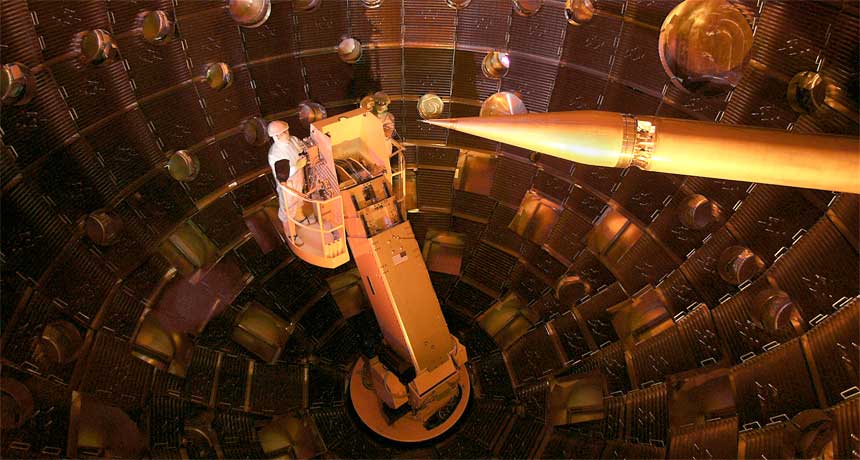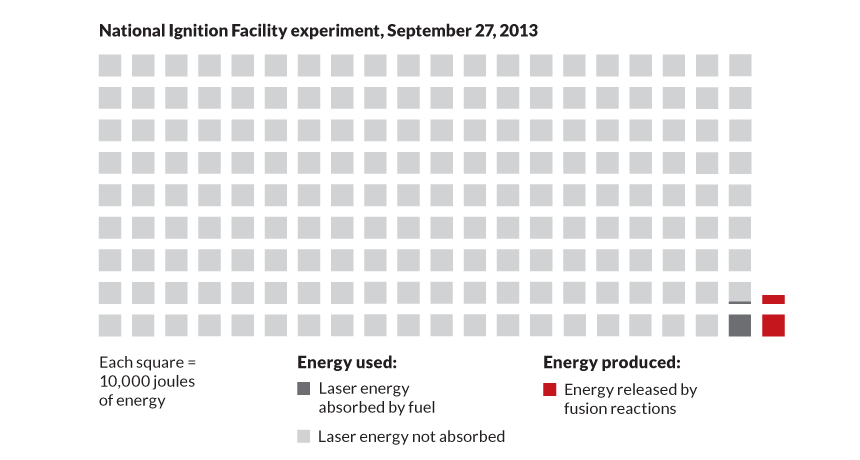
ALIGNING THE TARGET Workers perform maintenance on the National Ignition Facility’s target chamber. When devoid of people, this is where 192 laser beams fire simultaneously at a gold cylinder containing a capsule coated in hydrogen fuel. The positioner that holds the cylinder steady is at right.
Lawrence Livermore National Laboratory
A quick-hitting laser pulse has breathed new life into a multibillion-dollar effort to generate substantial amounts of fusion energy.
The 192 laser beams at the $3.5 billion National Ignition Facility have now triggered fusion reactions that briefly sustain themselves. The reactions, reported February 12 in Nature, produced nearly 10 times as much energy as the previous record for laser fusion research. But they still fall well short of recouping the energy supplied by the world’s most powerful laser.
“It’s a very important milestone,” says Steven Rose, a plasma physicist at Imperial College London. “However, there are many other milestones to pass.”
In 2009, NIF officials at Lawrence Livermore National Laboratory in California were a far more confident bunch. Computer simulations had suggested that a NIF laser pulse could compress a layer of frozen hydrogen within a peppercorn-sized plastic capsule to one thirty-fifth of its original size. The extreme pressure would drive up the temperature to 50 million degrees Celsius, causing pairs of hydrogen nuclei to fuse and cumulatively release more energy than the lasers supplied.
Had NIF achieved that milestone, known as ignition, it would have marked the first time a controlled fusion reaction generated more energy than it took to get started. “A lot of people thought this would be a walk in the park,” says Robert McCrory, the director of the University of Rochester’s Laboratory for Laser Energetics and a frequent NIF collaborator.
But NIF hasn’t come close. For reasons unknown, the fuel resists compression, often warping into bulbous shapes and tearing apart before much fusion takes place (SN: 4/20/13, p. 26). “Mother Nature doesn’t like putting a lot of energy into small volumes,” says Livermore physicist Omar Hurricane. “So she fights you on it.”
In May 2013, physicists fought back against nature by changing the timing of the laser pulse. Instead of ramping up the laser energy gradually in an attempt to achieve maximum compression, the researchers tried delivering an initial surge of high energy to swiftly drive the fuel inward symmetrically before it could tear apart. Initial experiments showed promise that this so-called high-foot laser pulse could overcome some of NIF’s problems.
Excitement peaked on September 27, when researchers fired a high-foot laser pulse with 1.8 million joules of energy at a small gold cylinder called a hohlraum that held the plastic capsule. More than 99 percent of that energy was lost as it cascaded from laser to hohlraum to the fuel inside the capsule. Nonetheless, an 11,000-joule infusion was enough to implode the fuel and spark a flurry of fusion reactions, transforming pairs of hydrogen nuclei into energetic neutrons and fast-moving helium nuclei. The newly formed helium then crashed into more hydrogen nuclei, transferring heat and spurring more fusion reactions.
During the 160 trillionths of a second of sufficient pressure and temperature, about 5,100 trillion fusion reactions took place. The reactions produced 14,000 joules — more energy than the fuel absorbed. That’s a first for any laser fusion experiment. However, it’s well short of compensating for the 1.8 million joules from the laser. It’s analogous to making a solid return in the stock market, but only after the broker took a commission of more than 99 percent of the initial investment. “It sounds very modest and it is, but it’s closer than anyone has gotten before,” Hurricane says. “That’s a major turning point in a lot of our minds.”
Much of Hurricane’s optimism stems from the fact that about half the 14,000 joules produced resulted from helium nuclei heating the fuel from within. NIF won’t achieve ignition, McCrory says, unless helium fosters a chain reaction that exponentially increases the fusion rate. A recent experiment, conducted too late to appear in the Nature paper, produced nearly 10,000 trillion fusion reactions — a target figure the NIF-overseeing Department of Energy has aimed for — that resulted largely because of self-heating.
The high-foot laser experiments also mark the first time that real-world results largely matched the predictions of computer simulations. Rose says that physicists are no longer working blind when considering new ideas to push closer to ignition. “If you ever want to make any progress, you’re going to have to do that with the aid of simulations you believe,” he says. Rose thinks physicists finally have that confidence.
To make progress, physicists have to slash the 99 percent commission so that the fuel absorbs more of the laser energy, as well as increase the return on investment by coaxing more self-heating. Researchers have a bunch of ideas to test in simulations and experiments, including changing the shape of the hohlraum, replacing plastic capsules with ones made from diamond and further tweaking the timing of the laser pulse.
McCrory warns that NIF is still a long way from ignition. But after more than four years of frustration, Hurricane and his colleagues finally feel like they’re on their way. “A lot of people are jazzed,” he says.








